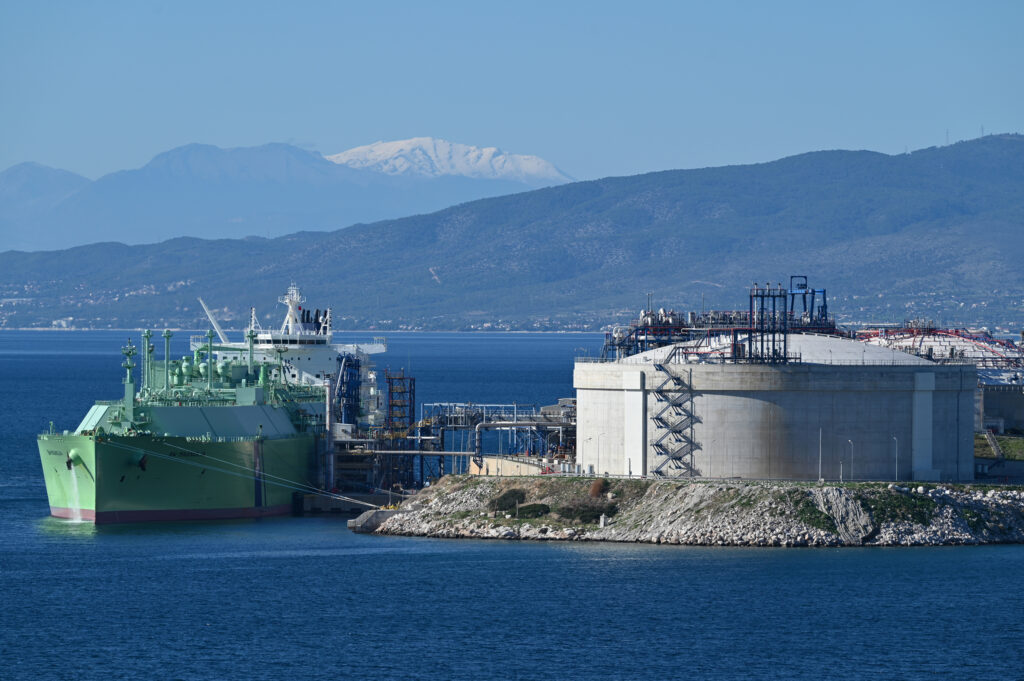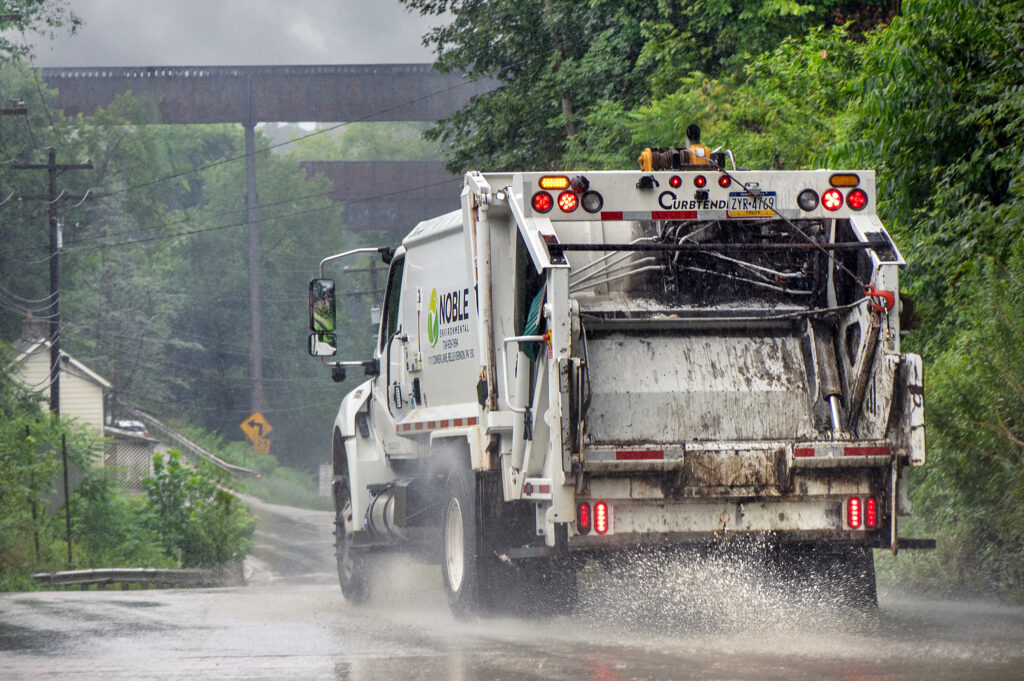Wyoming has the largest uranium ore reserves in the U.S., and for decades, uranium mining was one of the key drivers of the state’s economy. In the late 1970s, the state’s mining industry produced 12 million pounds annually of the element needed to fuel nuclear power plants, and was a major source of employment.
By the late 20th century, the U.S. uranium industry declined due to decreasing demand for nuclear power, falling market prices and competition from cheaper foreign sources. Uranium employment has typically tracked price trends, doubling from around 200 jobs in 2002, when the average price was $10.36 per pound, to more than 400 jobs in 2011 when prices peaked at $55.64. As prices fell in 2020, employment dropped below 200, but by 2024 had bounced back to 235.
But the nuclear industry is looking at a potentially more significant resurgence, and Wyoming is eyeing the possibilities.
As the urgency to transition to green energy grows, atomic power is being touted as one of the lowest-carbon electricity sources and experts argue that nuclear energy is poised for a revival, despite fears about accidents with radioactive materials, their potential contributions to the proliferation of nuclear weapons and the long-term storage challenges for waste that will remain dangerously radioactive for centuries.
We’re hiring!
Please take a look at the new openings in our newsroom.
See jobs
The latest generation of reactors—designed with cutting-edge technologies, materials and safety systems—offer a glimpse of nuclear power’s potentially promising future.
But, the first step toward that future is a more reliable supply of fuel.
The U.S. banned the import of Russian uranium in August 2024 in response to its invasion of Ukraine. In retaliation, Russia imposed a slap ban against the U.S. on enriched uranium imports in November. The U.S. uranium industry and government leaders have seized on the opportunity the import ban presents to boost domestic production to support the continued growth of nuclear energy.
But increased U.S. government interest in new nuclear technologies has also contributed to that expansion.
The Accelerating Deployment of Versatile, Advanced Nuclear for Clean Energy (ADVANCE) Act, which became law in July 2024, aims to promote the demonstration and commercialization of next-generation nuclear technologies in the U.S. The legislation marks a significant shift, enabling the Nuclear Regulatory Commission to update outdated regulations, particularly for advanced reactors. The federal government wants to partner with private companies to share costs, address nuclear waste management and position nuclear power as a leading clean energy source.
Wyoming is among several states looking to capitalize on that momentum.
The state has little experience with nuclear power, aside from a 1.25-megawatt nuclear plant built by the U.S. Air Force in Sundance in 1962 that closed after six years. But Wyoming made national headlines in June 2024 when TerraPower, an advanced nuclear energy company funded by Bill Gates, began construction in Kemmerer, a historic coal town in southwest Wyoming. The nation’s first sodium-cooled advanced nuclear reactor, which the company claims will be smaller in size, more cost-effective and safer than traditional reactors, would be built on the site of a retired coal-fired electricity plant. TerraPower plans to retain 109 of the coal plant’s workers and has already taken over its transmission lines and water rights.
“We really feel like this could be an example of how sources like nuclear can come in and backfill some of those generation needs as more coal comes offline,” said Jeff Navin, TerraPower’s director of external affairs.
The TerraPower project, combined with government incentives, Wyoming’s rich uranium reserves and its commitment to an “all-of-the-above” energy strategy, positions the Cowboy State as a potential leader in next-generation nuclear energy.
The Road to a Nuclear Resurgence Is Paved with Coal
TerraPower applied for a nuclear reactor construction permit with the Nuclear Regulatory Commission in April 2024, and the approval process will take around 24 months. In the meantime, it is building the non-nuclear infrastructure the project requires, including a research facility, training center and energy storage.
“A conventional nuclear plant actually looks a lot like a coal plant,” Navin said. “It’s really just kind of a fancy way to make steam.”
As opposed to a plant that burns fossil fuels to boil water into the steam that spins the turbines that generate electricity, a nuclear plant splits uranium atoms in a process called fission to heat the water.

Traditional nuclear plants also use water as a coolant for the fuel rods to prevent a runaway chain reaction that could lead to a meltdown. But TerraPower’s 345 MW reactor, about one-third the size of traditional gigawatt reactors, will use sodium as a coolant instead of water. Liquid sodium has a higher boiling point than water, making it more effective for heat absorption and reducing the need for complex safety systems. This simplified design, according to Navin, also avoids the type of vulnerable backup systems that failed during Japan’s 2011 Fukushima disaster. There, a massive earthquake and tsunami disabled the plant’s diesel generators, which were crucial for cooling the reactors, ultimately leading to core meltdowns and the release of radioactive materials.
In 2030, TerraPower is slated to begin supplying electricity directly to the grid, which is their primary focus. But Wyoming is also exploring off-grid applications, aiming to meet the high energy demands of industries that require ample, reliable, clean energy, but don’t get it from the system that distributes energy to other users across the region.
“In the U.S. today, nuclear energy primarily contributes to bulk grid generation—but the grid accounts for only 40 percent of our total energy consumption. Nuclear isn’t touching the remaining energy that we use,” said Steve Aumierer, senior advisor for nuclear energy strategic programs at Idaho National Laboratory (INL). “A world of 8 billion people needs to be able to plug this zero-emission energy generator into far more than just grid-scale processes.”
Aumierer said that both China and Russia are advancing innovative nuclear applications. China, he explained, diverts steam directly from large reactors to power chemical facilities, while Russia uses small nuclear reactors to support microgrid operations in Arctic regions. He added that these countries have yet to commercialize microreactors for industrial use—a gap the U.S. could capitalize on.
“Our country has an opportunity to lead in bringing microreactors to power mining operations, remote sites and incremental industrial plants,” Aumierer said. “It’s a push by Wyoming to usher advanced nuclear energy into this whole other portion of our energy demand that it’s not touching right now.”
As coal-fired power plants retire, many companies that once relied on them are seeking alternative energy sources. Natural gas has long been the next option, but with increasing pressure to achieve carbon-free operations, industries are looking for greener solutions.


Wyoming’s Innovative Entrepreneurs (WIE), a newly formed coalition of state manufacturers, is aiming to seize new business opportunities in nuclear energy. Members of the coalition have partnered with the Idaho National Laboratory for research and development support and BWX Technologies (BWXT), a leading producer of nuclear reactors and a key player in both commercial and government nuclear sectors. The coalition identified microreactors—compact reactors generating between 20 and 300 megawatts of power—as a promising solution for Wyoming, particularly for remote, off-grid and industrial applications. Mike Wandler, president of Gillette-based L&H Industrial and a member of WIE, saw this as an opportunity.
“Microreactors are particularly appealing because they offer a chance to build a new, diverse supply chain from the ground up—something that hasn’t been done before,” Wandler said of the need to develop everything from uranium fuel supplies to reactor construction projects and a customer base. “This presents a unique economic opportunity.”
But while he identified a need for microreactors in Wyoming’s industries producing steel and the minerals trona and bentonite, he noticed an issue.
“I went with a BWXT representative, and we found that the businesses were open to the idea of a nuclear reactor but nobody wanted to own or operate the reactor,” Wandler said. “It was an opportunity no one was taking.”
So in 2022, Wandler started up Evercore Energy, an “integrator” that would own, operate and license microreactors to provide energy for industrial clients. “Someone needs to bring together all the parties required for community engagement, socioeconomic analysis, site development and connecting the reactor to the heat and power systems at industrial facilities,” said Marcio Perez, CEO of Evercore Energy. “That’s where we come in as the integrator.”
Evercore positions itself as agnostic about how the electricity it provides is generated, presenting clients with a range of options and evaluating each for costs and environmental impacts. “I think nuclear microreactors will end up being the best choice for most, but maybe not all customers,” said Wandler.
Perez highlighted nuclear energy’s reliability and efficiency, noting that microreactors require minimal refueling, produce low emissions and are cost-effective compared to storing renewable energy or capturing the carbon produced by burning natural gas. “When you compare different options, nuclear is currently the most affordable, reliable and resilient choice,” Perez emphasized.
As a pioneer in this emerging field, Evercore is currently focused on community outreach, market development and raising awareness. Their efforts have already resulted in their first contract: a partnership with BWXT and Tata Ash Chemicals, a trona production plant in southwest Wyoming. BWXT will construct eight microreactors for Evercore that will be deployed at Tata Ash’s facility to replace coal-powered operations.
Baking Soda Operation Hopes to Move Fast on Nuclear Power
Green River, a small town in southwest Wyoming, is known as the trona capital of the world. Trona, a naturally occurring, white, crystalline mineral composed of sodium carbonate, is mined here and processed into soda ash, more commonly known as baking soda. Tata Ash Chemicals, one of Wyoming’s leading trona producers, mines trona ore, which is then crushed, mixed with water, and heated with steam to extract the soda ash. The plant relies on Rocky Mountain Power for electricity to power its operations and also uses its own coal and natural gas boilers to generate steam used in the soda ash refining process.
Trucks loaded with coal arrive and unload their cargo in an open area next to two three-story buildings, one that houses the coal-fired boilers to generate steam.
“The entire structure will be dismantled once we fully transition to nuclear,” said Jon Conrad, Tata’s director of governmental affairs and a representative in the Wyoming legislature, as he drove around the refining plant above a 55-square-mile underground trona mine.




As Tata looked at eventually phasing out coal, it considered natural gas and other renewable energy sources like wind and solar, but nuclear emerged as the most feasible solution to consistently generate steam with minimal carbon emissions.
“Unlike a power plant, we’re an industrial operation,” Conrad said. “Ninety percent of our need is steam, with only ten percent in electrical power. There’s no way solar or wind alone could produce the volume of steam we need to run efficiently.”
The company has committed to reducing greenhouse gas emissions by 30 percent by 2030, driven in part by the impending 2026 retirement of the mine in Kemmerer that supplies its coal. This broader trend of coal mine closures and coal-fired plants transitioning to alternative energy sources, such as natural gas, accelerated Tata’s search for a sustainable energy solution.
“We see small modular reactors as a way to meet both our sustainability targets and our steam needs,” Conrad said. “After the initial investment, the cost should stabilize, making nuclear a beneficial long-term solution.”
The microreactors will be set up off site, with the exact location yet to be determined. BWXT is in the process of designing and evaluating the reactors, with a production plan anticipated soon.
“We want to be the fast movers and lead the way by creating examples,” Conrad said.
Emergence of New Industries
Wyoming isn’t just aiming to bring nuclear facilities into the state; it’s looking to establish an entire supply chain around the technology to boost the local economy.
The chain starts with uranium, the primary raw material for nuclear energy, which Wyoming has in abundance. In 2024 alone, the U.S. produced around 180,000 pounds of uranium, with Wyoming’s four uranium mines responsible for approximately 63 percent of that output.
Before the ban on the import of Russian uranium, the U.S. uranium industry endured decades of decline, beginning in the 1980s when cheaper imports of the element—primarily from Russia and Kazakhstan—undercut local production. Russian supply was especially influential, mainly due to an enriched-uranium-buying deal between Russia and the United States designed to promote Russia’s peaceful nuclear program after the Soviet Union’s collapse. That deal enabled Russia to corner half the global market.
By the 2000s, competition from foreign sources and cheap domestic natural gas and renewable energy left U.S. uranium production dwindling. By 2020, domestic production met just 5 percent of U.S. uranium needs, with Russia providing about 20 percent of the enriched uranium for American reactors.
This story is funded by readers like you.
Our nonprofit newsroom provides award-winning climate coverage free of charge and advertising. We rely on donations from readers like you to keep going. Please donate now to support our work.
Donate Now
But the U.S. ban on Russian uranium imports after its invasion of Ukraine exposed the country’s dependence on foreign supplies. The ban, along with initiatives like the Civil Nuclear Credit Program, a $6 billion initiative that provides financial support to nuclear reactors that are at risk of closing for economic reasons, and the incentives for nuclear power in the Inflation Reduction Act, have sparked a push to revitalize domestic uranium mining and production.
Instability abroad has prompted U.S. utilities to diversify their uranium supply chains, aligning with a federal goal to increase domestic production. A series of executive orders issued since the beginning of the year reflect this push, though the specific impacts on various forms of uranium are still unfolding. For example, an executive order issued April 2 imposes reciprocal import tariffs on most countries of the world. While Canada was exempted from this specific tariff, it faces a separate 10% tariff on energy products—including enriched uranium—set to take effect April 9.
Ur-Energy, which operates Wyoming’s largest uranium mine at Lost Creek in Sweetwater, reported that market conditions were challenging between 2018 and 2020, with prices plummeting to $20 per pound—half of what the company needed to break even. However, recent revitalization efforts in the nuclear industry have led to a positive shift in the market.
“While not helping us directly, a few legislative efforts have bolstered nuclear power plants across the nation,” said Ryan Schierman, vice president of regulatory affairs at Ur-Energy. “And many of those power plants that were going to be decommissioned have come out of decommissioning and gone back into operations.”
The mining of uranium is only the beginning of the nuclear fuel cycle. After Ur-Energy digs up the ore, it processes and concentrates it into “yellowcake,” a product that must undergo further refining and enrichment at other facilities to become usable in nuclear reactors. Wyoming has abundant uranium resources but lacks the infrastructure to produce uranium enriched enough to fuel nuclear reactors. Ur-Energy currently sends yellowcake to the nation’s only uranium conversion facility, located in Metropolis, Illinois, which converts yellowcake into uranium hexafluoride (UF6), a gas that is then sent to enrichment facilities.
“The value chain actually lies in the concentration, enrichment and fuel fabrication process of uranium,” Schierman said.
While Wyoming stakeholders are considering the potential for local enrichment facilities, this remains a distant goal. Such plants require significant resources and personnel that Wyoming currently lacks, Sean Schaub, Nuclear Industry Coordinator of BWXT, pointed out.
“Wyoming’s uranium reserve is very useful from the standpoint that the state is familiar with what the fuel supply chain looks like,” he said, “but the reality is far from ready to host an enrichment plant.”
One of BWXT’s prime enrichment facilities, in Lynchburg, Virginia, employs around 2,000 people, a workforce that Wyoming could struggle to match, Schaub said.
To provide the components for the construction of a small modular reactor, Wandler’s L&H Industrial has partnered with BWXT to supply parts that will be deployed at Tata Ash.


L&H, which specializes in industrial machinery, operates a 10-acre facility in Gillette that produces heavy equipment for surface mining, including large shovels, draglines, mineral processing tools, crushers and refurbished wind turbines. In addition to mining, L&H also supplies equipment to space agencies and companies, including NASA, SpaceX and Blue Origin. Recently, the company designed, manufactured and installed the undercarriage for NASA’s crawler transporter, which is responsible for moving space shuttles to the launch site.
With more than 60 years in heavy machinery, L&H is shifting its focus to developing components for small modular nuclear reactors at its facility in Gillette. The facility already houses a workshop that produces small-scale equipment, including bolts, cutting tools and other miniaturized machinery. However, the company is constructing a dedicated facility exclusively for manufacturing small-scale nuclear components.
“We’ve just quoted some graphite and steel parts for microreactors, and we’ll take on more orders as the project moves forward,” Wandler said. Emphasizing the broader economic potential for Wyoming, he’s working to involve other entrepreneurs through WIE.
“I want all of Wyoming to participate in the microreactor supply chain. I’ve been in this business long enough to know there’s room for everyone,” Wandler said, “Only abundance, no scarcity,”
Wyoming’s government is also heavily invested into this nuclear supply chain expansion goal.
In July 2024, the Wyoming Energy Authority (WEA) signed an agreement with BWXT to conduct an assessment study on the establishing of a Tristructural-Isotropic (TRISO) nuclear fuel fabrication facility in the state, which will primarily cater the need.
TRISO fuel is composed of a tiny uranium core encased in three protective layers of carbon and ceramic materials to contain the radiation. “It’s a fuel where you can put tiny uranium pebbles, about the size of a pen tip, and have several coatings around that fuel,” said Aumierer, at the Idaho National Laboratory.
These protective layers make TRISO particles exceptionally durable, able to withstand very high temperatures without melting or releasing radiation, so it’s highly desirable for microreactors and small modular reactors as well as larger advanced reactor designs, Aumierer said. The U.S. Department of Energy describes TRISO fuel as “the most robust nuclear fuel on Earth.”
People working to revive the nuclear industry think Wyoming has become ground zero for developing microreactors, but this notion also reflects society’s changing perception of nuclear energy in general.
“When I started out, the outlook for nuclear technology was very negative. Now, after 35 years into nuclear engineering, I’m witnessing this resurgence of interest,” Aumierer said.
About This Story
Perhaps you noticed: This story, like all the news we publish, is free to read. That’s because Inside Climate News is a 501c3 nonprofit organization. We do not charge a subscription fee, lock our news behind a paywall, or clutter our website with ads. We make our news on climate and the environment freely available to you and anyone who wants it.
That’s not all. We also share our news for free with scores of other media organizations around the country. Many of them can’t afford to do environmental journalism of their own. We’ve built bureaus from coast to coast to report local stories, collaborate with local newsrooms and co-publish articles so that this vital work is shared as widely as possible.
Two of us launched ICN in 2007. Six years later we earned a Pulitzer Prize for National Reporting, and now we run the oldest and largest dedicated climate newsroom in the nation. We tell the story in all its complexity. We hold polluters accountable. We expose environmental injustice. We debunk misinformation. We scrutinize solutions and inspire action.
Donations from readers like you fund every aspect of what we do. If you don’t already, will you support our ongoing work, our reporting on the biggest crisis facing our planet, and help us reach even more readers in more places?
Please take a moment to make a tax-deductible donation. Every one of them makes a difference.
Thank you,

















